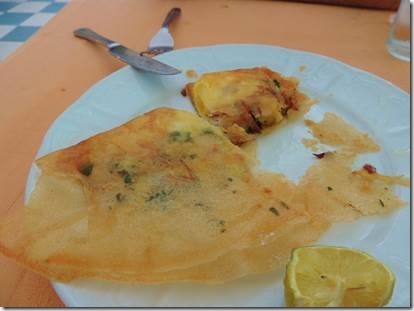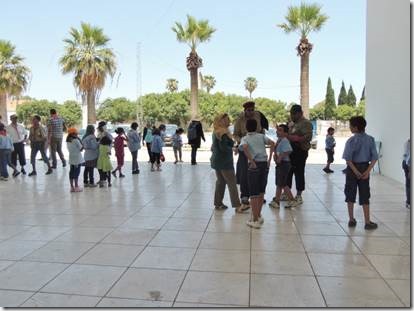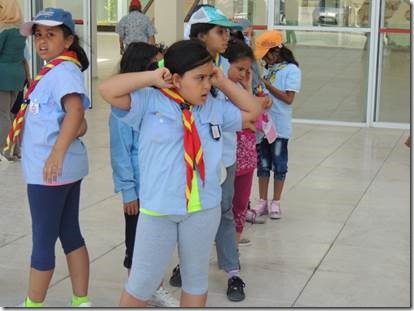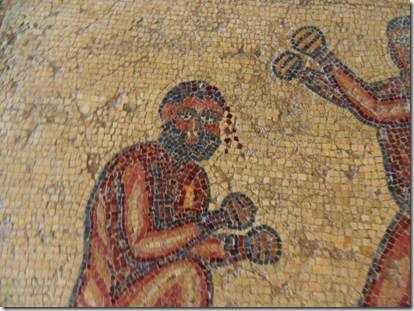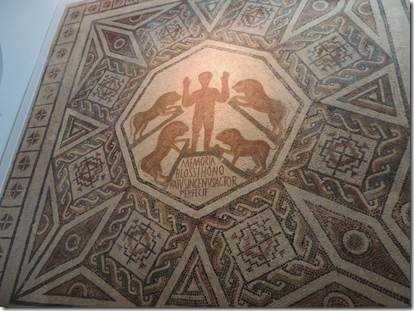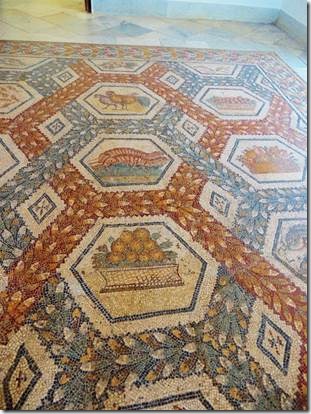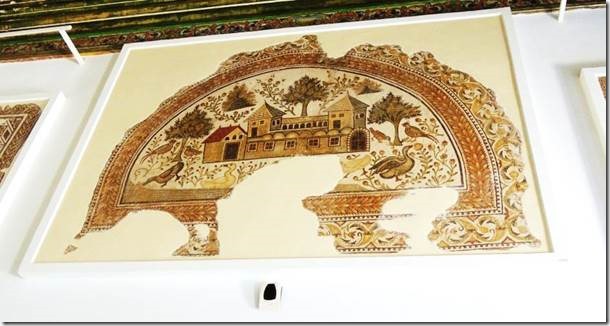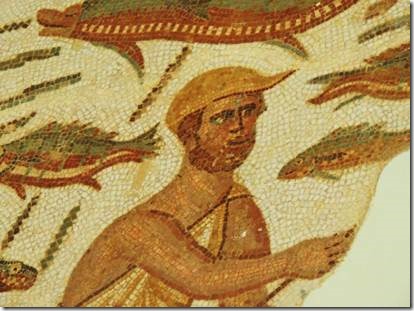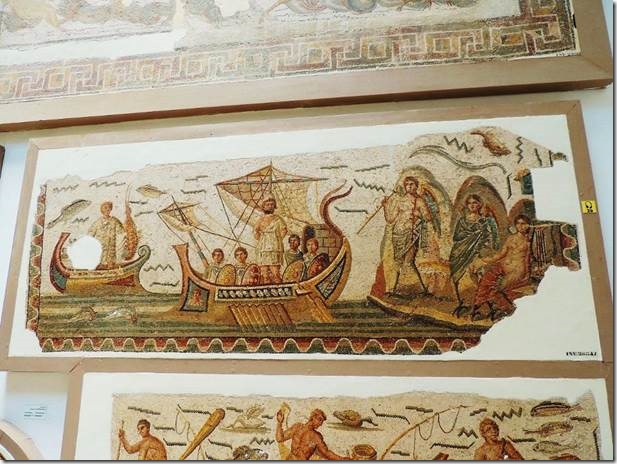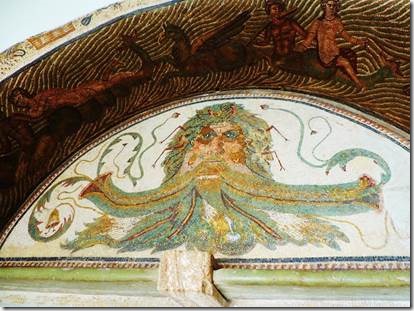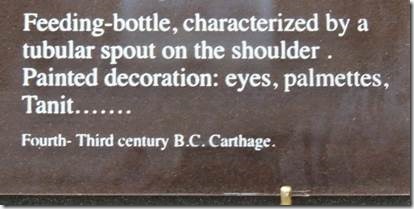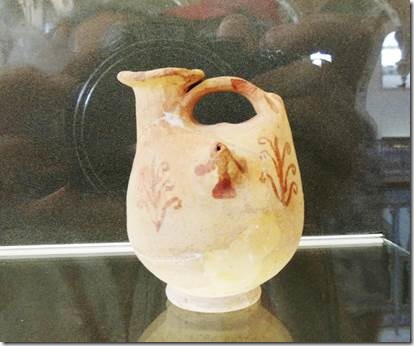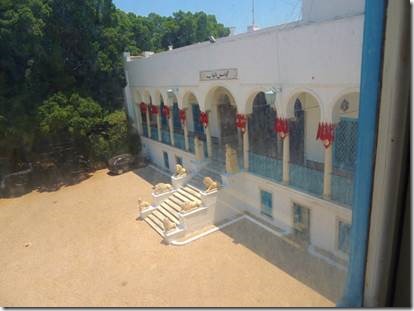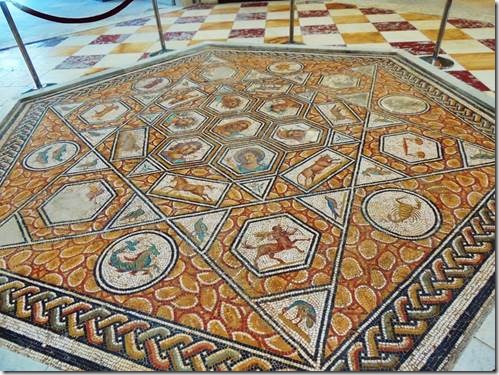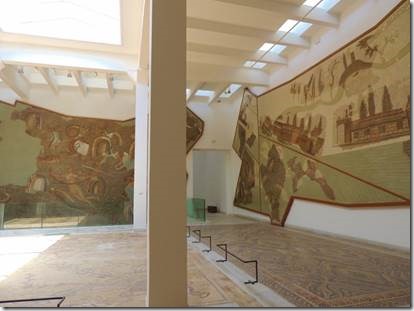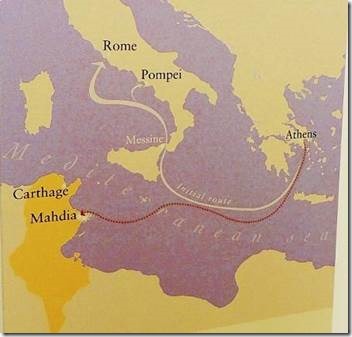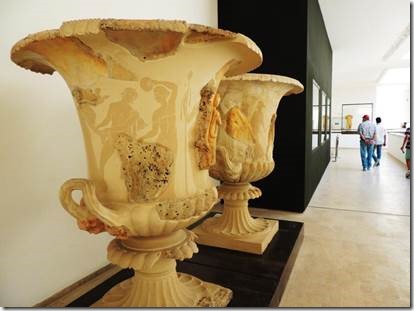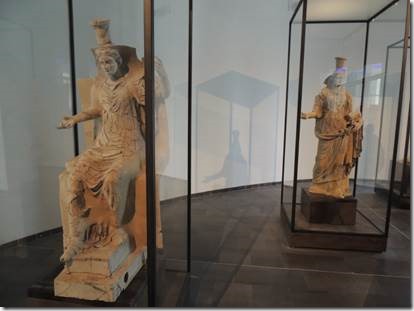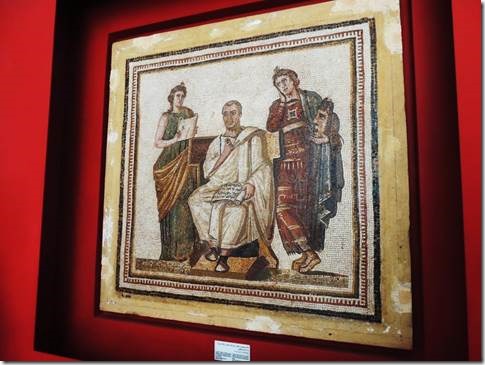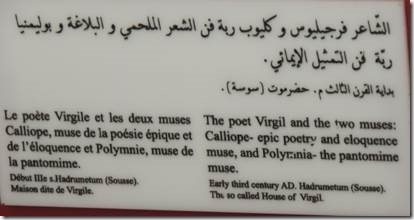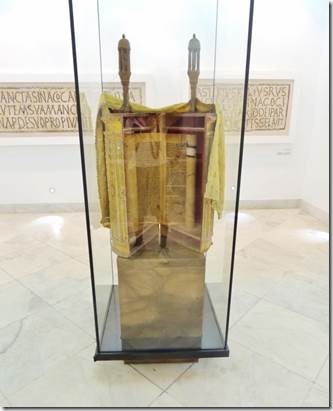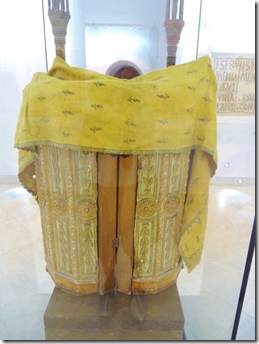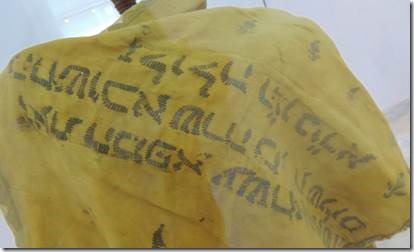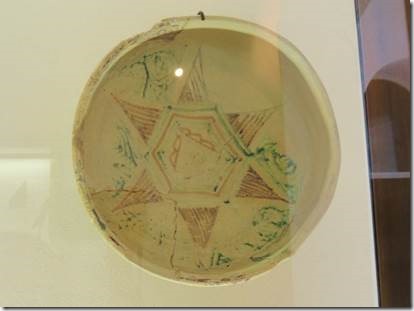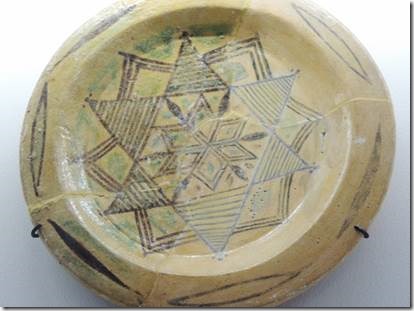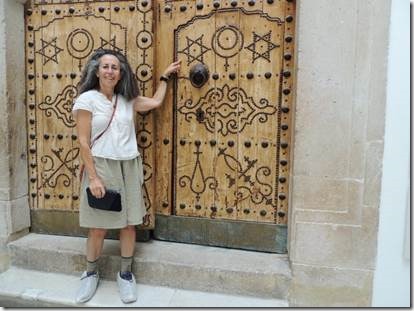Hola,
I’ve made myself a little crazy writing up our visit to The Bardo. Another one of those wild tangent emails that is interesting to me so hopefully doesn’t bore you to tears. It really is quite interesting reading about the imagery of mosaics and what they say about the culture that inspired them. Some art can be ahead of its time, but I’m not sure that could be said about mosaics though it shows the changing beliefs of the cultures that commissioned them. I also might have found an error in our huge mosaics book. You’ll read about that below concerning what might or might not be an image of Daniel in the Lions Den.
Ru
The Bardo http://www.bardomuseum.tn/
http://www.bardomuseum.tn/ link to the 101 Masterpieces in the museum
Randal and I drove off to Tunis to see the Grande Synagogue, the huge Medina Souk, and the Bardo. By the time we extricated ourselves from the giant weekend before Ramadan traffic jam surrounding the central Medina we decided to skip the center and aim for the Bardo. Miraculously we found it, because though we had a small Tunis map which showed the Bardo, we had no idea where we actually were on the map. And as we’d been inching our way through the streets near the Medina one young man passing by told us the Bardo was closed on Sundays. (So much for asking directions.) Thankfully the museum was open as we’d opted for Sunday with less traffic..ha!
We found the museum, found the parking lot, found the entrance but then found that the cafeteria wasn’t opened. We needed some food before we started our Bardo tour so went off to find some. Between the clerk at the Bardo and a nice man on the street we finally found a restaurant that served more than coffee. Ever since we left Greece finding lunch has been a bit tricky….unless your idea of lunch is gelato. (Lunch in Gibraltar is easy)
|
“brique – crepe filled with tuna, cheese and an egg — eat with your elbows pointing up so the egg yolk doesn’t run down your arms. “ Our friends Eileen and George included this in their Tunisia tips email. It is more crispy fried than a crepe and our egg was hard cooked so we didn’t have to worry. Randal and I split one and then each had a Salad Nicoise. Too much food. |
|
Troops of boys and girls….in seperated groups. Remember when you were this age and had to go to a “don’t touch anything” musuem. I have a hard time not touching things in museums now. |
The National Bardo Museum
This is the oldest and the most important of Tunisian museums. Over a century ago, it was established in the premises of a Beylical palace, for the most part built in the mid XIXth century, and which has retained all the features of a princely residence. It underwent several refurbishments to adapt to the expanding collections and to the ever-increasing flows of visitors, but today it is undergoing a huge restructuring plan to improve its visibility and legibility.
Thousands of objects originating from excavations carried out all over the country during the XIXth and XXth centuries are on display. These are divided into departments between fifty or so rooms and galleries, illustrating the various stages of Tunisia’s history, from prehistory to the middle of the last century, which in chronological order are prehistory, the Punic-Libyic period, the Roman and early Christian periods, with the Vandal and Byzantine eras, and finally, the Islamic period running to contemporary times.
Thanks to its collection of mosaics, the Bardo museum has gained an international reputation for the richest, the most varied and the most refined collection. Amongst the finest pieces it holds are the representation of Virgil surrounded by muses, or the pavement of Dionysos giving Ikarios the gift of the vine, or another celebrating the triumph of Neptune, to mention only a few of the key exhibits. But these are not the museum’s only assets.
Amongst the Bardo’s major exhibits is the “hermaion”, an altar dating to the Mousterian period (-40 000 years ) considered as one of the very earliest forms of human spiritual expression: a conical shaped pile 75cm high and 1.50 m wide , composed of more than 4000 pieces of flint, bones and limestone balls.
From the Punic period there is a superb solid gold armour belonging to a Campanian warrior, jewellery, the stele of a priest carrying a child for sacrifice as well as many refined funerary furnishings originating from various Mediterranean countries belonging to the Museum’s Greek and Egyptian collection.
The Greek collection was providentially enriched by underwater excavations carried out during the 40’s off the town of Mahdia, in the wreak of a ship that sank during a storm around the first century and that was carrying furniture and architectural elements for a Hellenistic era patrician dwelling. Amongst the masterpieces retrieved from the seabed is a superb 1,20m high bronze Agon.
The Roman period has provided the Bardo with most of its collections: mosaics, of course, but also statues, pottery, jewellery, coins, religious objects, utilitarian objects etc.
The Islamic department, housed in an Arab-Islamic setting, encloses objects from various periods, manuscripts, jewellery, carved stone and wood, utilitarian objects. Two small rooms, around an elegant patio, enclose objects that once belonged to the reigning family and a third room contains Jewish religious objects. http://www.patrimoinedetunisie.com.tn/eng/musees/bardo.php
We bought our tickets and found that there were “free” tours available. Each tour would take an hour and point out the various highlights. We could then tour on our own. We were joined by two men and a young boy all who spoke fluent English and French. Our tour was in English. But to cover everything in an hour our guide had to talk fast and that’s when his accented English became too hard to really understand. Our tour mates were able to understand him better so “translated” for us. Also they were extremely knowledgeable in Greek/Roman mythology and history. It was actually their second visit to the Bardo. They’d come once before but much had been closed for renovation.
|
I thought this man had a ribbon tied round his head until one of our tour mates pointed out that it was showing blood pouring from a wound. “Central picture of a pavement with a geometrical pattern showing two boxers. End of the 3rd Century AD Thuburbo Majus” p 296 The Splendors of Tunisian Mosaics by Mohammed Yacoub from now on referred to as The Splendors as I refer to it a lot. “The one on the left looks older judging by the features of his bearded face. Crouching and already defeated, he seems to be only defending himself. He is bleeding profusely from the wound on his temple. His friskier adversary closes in, both hands outstretched to deliver the final blow.” |
|
Daniel in the lions den or is it? “Pavement of the funerary chapel of the Blossii, a great senatorial family. It is decorated with a scene taken from the Ancient Testament showing the prophet Daniel in the Lion’s den.” “It was only during the course of the 5th century, under the influence of the sepulchral art that was the first to tolerate Christian religious imagery, that we see the appearance of the first figured scenes taken from the Scriptures, although they remain rare. In fact, we can but mention two mosaics to illustrate the subject, both pavements found at Borj El Youdi. The first covered the floor of a church and figures Jonas thrown away by the marine monster; the second adorned the mausoleum of a great Roman senatorial family – the Blossi - portrays Daniel in the lions’ den. Both scenes, for which the mosaicist had no ancient models available, are treated summarily, with figures simply outlined without shape or life.” Pages 380-381 The Splendor However when I was trying to find an explanation for the wood door (below) with symbols from Judaism, Christianity and Islam…I found the following which made me question if the mosaic above is supposed to be Daniel of someone named Blossi as the mosaic was commissioned by the Blossi family Roman Remains ‘ and Carthage 161 Then our minds went back to Church history, as we touched the very mosaic which had covered the remains of the martyr Perpetua, who was only twenty-two years of age, and went into the arena at Carthage brave as a lion, encouraging those with her, and leaving her father and mother and her baby-in-arms behind. She suffered death in a.d. 203, with her friends Felicitas, Saturninus and Revocatus, and her brother Saturus, who with her fought and died among the wild beasts for their faith, while all Carthage looked on, in the crowded theatre. There is a full-length mosaic portrait of her in flowing robes, with doves on either side of her, and the simple epitaph, " Perpetua in Pace." The simplicity of the epitaphs is very touch- ing ; all have the words " In pace," " Marciana, in pace dulcis," and many young martyrs’ names are followed by " Innocens in pace." " Blossi " stands with hands uplifted, two lions on either side of him. This large mosaic is full of emblems. ” Primulus " has two doves, and their outspread tails form a wreath ; in fact This early christian mosaic have been discovered in 1898 in the "Furnos Minus" (Messadine, Mannouba near Tunis) archaeological site, it has been since then moved to the Bardo museum where it is still well preserved and displayed (source: bit.ly/SCmunL). I think that "MEMORIA BLOSSI HONORATUS INGENUS ACTOR PERFECIT" means somehow "a tribute to the honorable memory of the dead (thrown in the lion’s den)" UPDATE : Thanks to S.Barton who suggested another translation : "Honoratus Ingenus (the name of craftsman) has made possible this work in honor of the dead" UPDATE 2 : A latin teacher at Jeddah French College, researched and translated "MEMORIA BLOSSI HONORATUS INGENUS ACTOR PERFECIT". As per his translation, the result is less romantic, and it seems that the mosaic has nothing to do with "Daniel in the lion’s den". The artist (craftsman) simply created this scene about a so called BLOSSIUS (probably a gladiator), he’s also glorifying himself through the same writing. The right translation would be : "A HONORABLE (or) RESPECTABLE AND FREE ARTIST REALIZED THE FATES OF BLOSSIUS" http://www.flickr.com/photos/mahfoudh/8056759568/ MEMORIA BLOSSIHONO RATVSINCENVSACTOR PERFECIT MEMORY Blossom honor APPROVED DINNER PLAYER Perfect is a possible Google translation depending on how you interpret what letters are actually meant as in… is it a V or U |
|
Mosaic Menu on the dining room floor Our guide said this mosaic had been in a dining room and suggested that it was a menu of the foods that were served there. |
|
Maybe we could have a Mill Mountain Star on our patio… “The trend to use data from their own observation of reality instead of the decorative elements belonging to the past started to emerge in the figurative repertoire of the African mosaics already in the middle of the 2nd C AD…The taste of the clientele did, of course, play a determining role in these changes….The newly acquired wealth and the taste for ostentatious luxury of this clientele was to a great extent responsible for the long and impressive series of mosaics illustrating events form the economic and social life of Roman Africa.” P 199 The Splendor |
|
Our guide pointed to this man’s “baseball cap” but had no explanation for its inclusion in this mosaic. |
|
“Ulysses passing in front of the island of the Sirens represented as bird-women towards 260 AD Dougga” Page 172 The Splendor Our mosaic artist friend AB had been commissioned to recreate this mosaic and in the small square in the stern, AB had to put in the man’s wife’s face. I thought I’d heard that the man who had commissioned the original is actually the man in the smaller boat and his face is in the square. But it really doesn’t look like his face so maybe it’s his wife’s face. See how stories get started! |
|
Model for Davy Jones in Pirates of the Caribbean; but really it’s described as Oceanus “The god Oceanus was just as popular as Neptune. Oceanus was generally figured as an enormous head, surrounded by fish, various boats and landscape elements…The success in Africa of Oceanus’ head is mainly due to the beneficent value attributed to it. In a country with scarce rainfall, it probably constituted an appeal to the regenerating and fertilizing water. Oceanus, furthermore, was not just limited to the marine environment, but was a god whose fecundating waters encircle the earth with a continuous current, penetrating its deep layers and resurging in the form of life-giving springs.” Page 162 The Splendor.
|
|
Clever! |
|
Visible from the museum was the seat of Tunisian government next door. |
|
“Mosaic of a cosmological nature figuring the divinities of the seven days of the week and the signs of the zodiac. Early 3rd century AD Zaghouan area.” Page 127 The Splendors |
|
In pieces, our guide said, this was the largest mosaic found (though I’m not sure the largest one in Tunisia? Africa? The World?) |
|
Routes of ships in the ancient world explaining shipwrecks with ancient artifacts that are found near Tunisia |
|
Artifacts retrieved from shipwrecks |
|
Statues of our old friends Persephone and Demeter |
|
This mosaic shows that they were more than art; they were history and sociology and great clues to the past. Virgil writing the Aeneid “But the most remarkable and probably the most faithful portrait of the poet found so far is incontestably that of Virgil shown in a very fine mosaic from a big house in Hadrumentum. The highly controversial date assigned to this famous work varies from the 1st to the 4th century AD. But it seems reasonable, on the basis of the clothing details, to date it to the beginning of the 3rd Century. The house in which it was found seems to have been abandoned towards the end of the 3rd c. when the whole town quarter in which it was located was destroyed by an undetermined catastrophe and converted into a necropolis. The two Muses are standing on either side of Virgil. Clio, the Muse of history is probably standing to the left. The young woman is wearing a long green silk tunic, partially covered by a yellow scarf. With both hands she is holding a partly unrolled manuscript as an attribute. On the right side is the Muse of Tragedy, Melpomene, a mask in her hand. She is wearing a long red embroidered robe and a green silk scarf. The poise of her head, turned to the left, the gesture of her right hand touching her cheek, and the position of her crossed feet gives her an artificial, almost theatrical pose. “ Pages 143-144 The Splendor The sign posted by the mosaic in the museum gives a somewhat different interpretation of which Muses are with Virgil. |
|
One interesting note is the gradual changes in the imagery of the mosaics beginning from the 1st to 5th and 6th centuris AD showing the change from “pagan” religious images to Christian images. “During this period where the new faith had not yet completely superseded the old, the voluntarily ambiguous decorations of masaics often offers no clue as to the relifious convistions of those who owned them and in general they could be interpreteds either as pagan or Christian.” P 360 The Spendor
As I was wandering around myself later in the afternoon I walked into the Christian area and found this Torah. But it seemed to me the shawl wrapped around it was upside down as you had to stand on your head to read the letters. I did go back to tell our guide and he came with me to see fearing I meant the Torah was upside down. I told him I wasn’t an expert so to check with someone else. He then showed me the plates with the Star of David on them and finally took me to the “Wood Door.” As we walked he told me that Tunisia had always been a place that welcomed Jews and it was sad that a small vocal minority could change that image of Tunisia. |
|
I think the shawl is upside down |
|
The plates with the Star of David |
|
Our guide said the door had two Stars and a Crescent with a Cross on it and offered to take my photo here. He hadn’t included the door as part of our tour but I had to wait my turn to have my photo taken as I guess it should be something pointed out if his interpretation is correct. The recent past of Ottoman Tunisia was inclusive of everyone. We were given booties to wear over our shoes to protect the floor mosaics that you actually walk on! |

